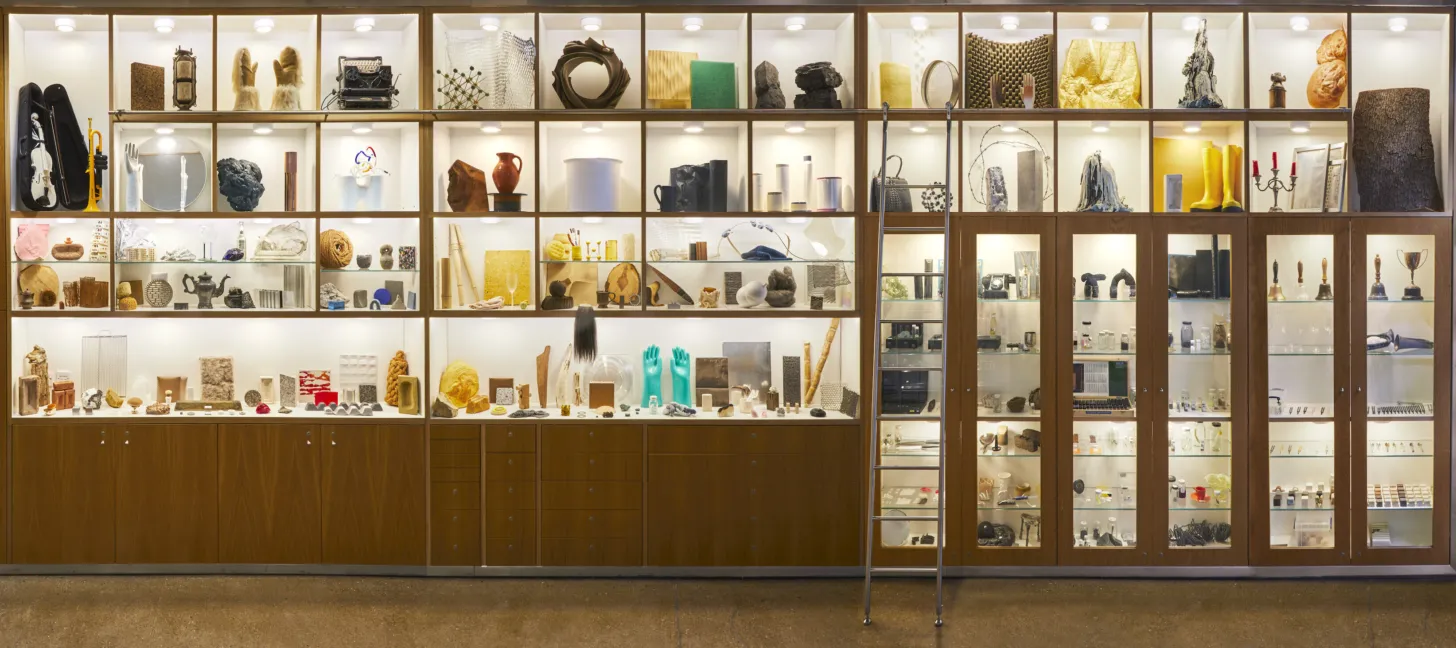- Home
- Materials Library
- About the Materials Library
About the Materials Library

Philosophy of the Materials Library
The Materials Library is a collection of some of the most wondrous materials on earth, gathered from sheds, kitchens, workshops, labs and factories around the world. Our shelves, cabinets and drawers are bursting at the seams with lumps, chunks and jars full of stiff, gloopy, shiny and nanoscopic stuff.
This collection puts familiar, everyday materials from our homes, studios and supermarkets on an equal footing with their more unusual counterparts - from research laboratories to high-tech manufacturing facilities - exploring the fascinating stories behind both the mundane and the mysterious.
The Materials Library is first and foremost a handling collection that emphasises the importance of sensory experience in learning about materials, their properties and their possibilities. You are encouraged to get hands-on and wobble, smear, scrape and sniff your way around the collection.
Our Materials Library is more than a simple collection of swatches: we have spent the last fifteen years developing an array of specially-made isomorphic ‘material-object’ sets that move beyond the swatch. Each set takes a recognisable form (like a cube, tuning fork, bell or spoon), and each object in the set is made from different materials. The individual objects in the set can vary wildly as a result of their material properties. These sets have allowed us to conduct systematic research, exploring the relationship between form, function and materiality.
The Materials Library is also a place that celebrates pure curiosity; encouraging play and experimentation with materials, as well as more formal research and teaching. As a result, we pride ourselves on our numerous ‘failed’ and ‘prototype’ materials, alongside those that are fully formed and ready to be specified.
Using the Materials Library
Our Materials Library collection is housed in our Bloomsbury and Stratford workshops. Our collections can be accessed by members during normal opening hours, and by visitors during our public events or via the growing digital catalogue.
The digital catalogue is the main tool for exploring and identifying materials in our collection, both remotely and when in the library. Each material in the collection has a unique number and a profile that includes images, audio or video of the material, stories about its histories and uses, sourcing information, and handling guidance.
The Materials Library is a multidisciplinary space, open to anyone who shares our fascination with the wondrous world of materials. Because each discipline classifies and orders materials in different ways, we have made a deliberate decision not to group materials by family or process. Materials are added to the collection chronologically, and they have no fixed place on the shelves. As a result, there is always an element of serendipitous discovery when browsing our library: you may become fascinated by the foamy, extruded cheesy wotsits next to the porous bioactive glass scaffolding you were looking for.
The Materials Library also aims to celebrate the many different disciplinary lenses that can be brought to the same materials. One person might be interested in everything that is pink, another visitor might be fascinated by stickiness, and yet another might want to get stuck into everything that is conductive. This is reflected in the functionality of our digital catalogue. You can search by an eclectic range of keywords (e.g. edible, auxetic or sonorous), use the filters to explore different properties of interest (e.g. process, colour, form), or browse our curated selections of materials (e.g. Bodily Materials, Waste or Cubes). You can also curate your own selection of materials that delight, disgust, intrigue and inspire you in the Bookmarks area.

History of the Materials Library
The Materials Library was established in 2005 by a team of passionate material addicts: Zoe Laughlin, Mark Miodownik and Martin Conreen.
In 2010, the collection became the central resource of the newly founded Institute of Making, and in 2012 the entire project moved to a specially designed new space at University College London (UCL), at their Bloomsbury campus.
In 2024, the Materials Library expanded to a second space at our brand-new Stratford Institute of Making workshop.
The original Materials Library collection is still housed in our Bloomsbury workshop, and is managed by our librarian Sarah Wilkes. A second, smaller collection can be viewed in our Stratford space.




